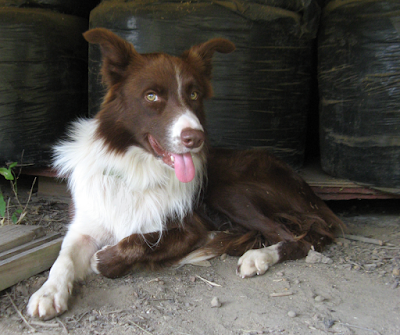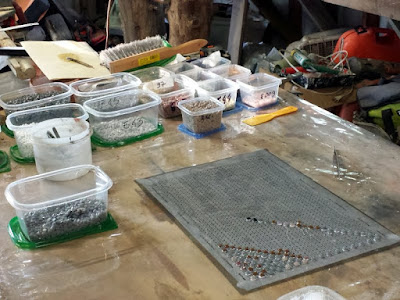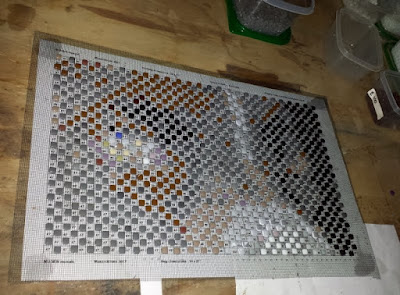Generally, mosaic artists do not start in life as artists, and it is fascinating to discuss with them how they got into the Art. I first met Daniel Adams last April 2017 in Decatur, Georgia at a mosaic seminar co-hosted by Mosaic Art Supply.
 |
| Printmaker Artist Daniel Adams working on a plate. |
I had invented my Opus Pixellatum mosaic technique in 2015 to build several portraits of the eyes of Yezidi refugees. As I assembled the mosaics, I realized the technique allowed for such a wide range of variations that I was going to need help to figure them out.
And so Joe Moorman and I co-organized this event -seminar to get people started in Opus Pixellatum by building a mosaic portrait of their own eyes.
Daniel had to spend several weeks on other projects, and after a few weeks got in a frenzy and created many mosaics based on the model from the seminar. That was exactly what I was hoping someone would do!
Daniel kindly agreed to answer questions I had about his Art. I hope you enjoy his interview :
1. Daniel, when we first met last April in Decatur, GA, I understood that you are an Artist and an Art teacher. Can you tell us a little more about Art.
Art is a creation of humanity. Every society that is functioning has this activity as a part of it. “Art”, or the arts (visual, music, dramatic, poetic, literary, dance, etc) are expressions of the artist(s) thinking and feeling about certain subjects. The subject matter of art ranges widely including: simple observation of the natural world, mystical interpretations, religious devotion, political activism, social commentary, abstract symbolism, and deeply personal therapy. Some artists simply play around with forms (colors, compositions, lines, patterns, etc) to see what shows itself as something interesting to contemplate.
2. One day, during a trip to Greece, you got interested in Mosaic. Can you tell us what happened, and how you got started?
I teach art and design at Harding University in Arkansas. We have a number of international programs—one of which is Harding University in Greece (HUG). We study academic subjects, such as the humanities, Biblical archeology and Modern Greek. We also explore the Greek Islands and other nations close by (Egypt, Turkey, Israel.) My interest in mosaics was piqued as we were traveling through northern Greece and came to the ruins of Pella, the birthplace of Alexander the Great. The stone mosaic floors of the wealthy houses that had been uncovered were amazing.
 |
| Floor Pebble mosaic in a wealthy house of Pella, Macedonia |
As a printmaker, many of the techniques we use to create images involve pattern and these floors were covered in intricate patterns made of stones. I had seen glass tesserae mosaics in Rome and Ravenna in Roman and Byzantine churches before. They were nice, but for some reason the effect of the repetitive stone patterns spoke to me. After the semester in Greece I returned to my normal printmaking and didn’t think much about it.
3 - Please tell us about some of the mosaics you created - not including the Opus Pixellatum ones, we will address those later – How did you get started? And what are your main sources of inspirations?
A few years later I had the blessing to be able to take art students to Ghana, West Africa, to paint murals in an orphanage near the southern coast of Ghana. There I fell in love with the abstract patterns of palm fronds. So once back home, I began a series of black and white prints of these fascinating patterns.
 |
| Palm Frond print by Daniel Adams |
And I began a mosaic to create a large piece based on palm fronds to go above the front door of our house.
 |
| Palm Frond Mosaic by Daniel Adams |
After that, I have planned to do a floor mosaic at the entryway below these same doors. But I didn’t yet have enough experience to tackle an eight foot by three foot entryway. So I waited (and am still waiting.)
This past year, as a way to get our entire church community involved in a creative activity, I proposed, planned and (the congregation) completed a three by eight foot mosaic that addresses the Grace and Truth of Christ and our privilege to shine like stars in a world filled with darkness. This was completed in April 2017.
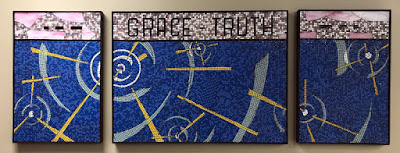 |
| Grace and Truth, 3 x 8' (1 x 2.4m) Mosaic designed by Daniel. |
My inspirations for subject matter come from observations I make while traveling and from my deeply held faith.
4. As I said earlier, your investigating the many possible variations of Opus Pixellatum is exactly what I was hopping would happen after our April Mosaic Fiesta. Please tell us how you got started doing in this research and experimental work. Did you work at random, or did you have an Ariadne thread to follow?
For me, and for most formally trained artists, it is standard operating procedure to work through themes and variations and to play around with media to really get a feel for what you can say and how to manipulate the medium to best effect. Any media is like a language. The more comfortable you are with what is possible and how you can use it, the more fluid and natural your creations.
To be honest, I didn’t like the looks of the first grayscale “eye” mosaic (OP fig. 1) that we did at the workshop. My particular pixellatum pattern was a compressed value range of only five values, rather than the normal seven values that were present in the others’ projects. So the depth of value range was just not what I wanted to end up with. But I knew I had to work the process, first, in order to understand the limitations.
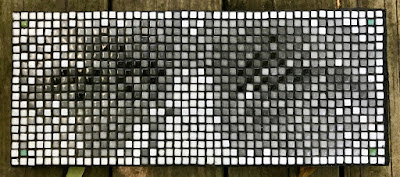 |
| Opus Pixellatum Eyes Mosaic Portrait - Original version. |
My second attempt (OP fig. 2) was simply adding color (shades of green) and playing with a more interesting border. The framing helped and I adjusted my placement of the different values to get a “better likeness.” That one was better, but it still didn’t satisfy.
 |
| Opus Pixellatum Eyes Mosaic Portrait - Variation #2 |
The next variation (OP fig. 3) I decided to blow the color palette out and include multi-colored tiles of various sizes, yet maintain the values structure of the pixellatum pattern that Fredric supplied at the workshop in Georgia. This one started to jump and come alive! I decided to play up just top and bottom borders of strong black and white pattern.
 |
| Opus Pixellatum Eyes Mosaic Portrait - Variation #3 |
For the next one (OP fig. 4) —still following the underlying pattern— I wanted to vary colors, again, but this time more subdued earth tones—and see what would happen by adding in natural stones (like the ones I saw at Pella.) I also decided to reorganize the structure by adding in vertical bars of grayscale values to add interest.
 |
| Opus Pixellatum Eyes Mosaic Portrait - Variation #4 |
The last of the theme and variation (OP fig. 5) on the workshop model was to do a triptych of the original grayscale image. I recreated the central “half” of the mosaic just as it had appeared in the first one, but then left the two side panels using common playground gravel to make a natural stone mosaic that followed the forms, but transformed them back to a more traditional look—it created an interesting dichotomy between digital and natural that I find very satisfying. With this one I also experimented with locally applied grouts of different colors to see what that would do to the final look of the piece.
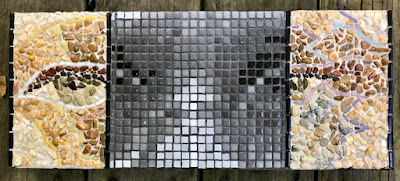 |
| Opus Pixellatum Eyes Mosaic Portrait - Variation #5 |
5. How do you now feel about the variations allowed by Opus Pixellatum? Would you recommend the technique to mosaic beginners?
I think for untrained individuals who are wanting to explore mosaic in a more structured way, Opus Pixellatum gives them the confidence to move from simply “filling in the dots” to exploring how variations and personal choices change the status quo, and how that can be so exciting.
Remember that Vincent van Gogh created between 36-39 self-portraits in a three-year time span (1886-1889). We learn through doing and repetition. Hey, if it’s good enough for Vincent, it’s good enough for me!
6. Joe Moorman and I are considering launching an open Opus Pixellatum Challenge. We provide a model and an indicative list of tiles for people to use, like you have done with the model of your eyes. This way we should be able to see a great number of variations from a unique model. How do you feel about this?
I think this would be great fun. Do I understand that this would be the same model for everyone and then they would all just go at it, approaching it in their own unique way?
 |
| Possible model for Opus Pixellatum mosaic challenge |
That's exactly what we have in mind. I am considering using the picture above as model, as several people have created many variations of her already. We believe this would allow people to
realize the potential of this technique for improvisation !
7. Daniel, do you think your Etchings and Mosaic techniques have influenced each other in your Art?
I am just beginning to explore the connections between how I have been creating prints over the years (both etchings and relief prints) and the aesthetic challenges posed by mosaics. I have been working on a series of glass block window relief prints for about eight years now. (RP figs below). I am exploring light with these prints. I’d like to see what I can do with this same pursuit of light with mosaic tiles.
 |
| Sunset - Relief Print. |
8. What are your goals, Art wise, for the next 2 years?
My
artistic goals for the next two years are to continue exploring light
and composition through the glass block series (both print and mosaic)
and to see how I can combine my third love —sketch notes— into a larger
format using printing techniques, large drawing and possibly mosaic
drawing (much like Marc Chagall’s walls in Chicago—but not that large!
 |
| Afternoon Warmth - Relief Print |
|
9. Where can we see your Etchings and Mosaics? Please provide links so we can enjoy your work.
One of the issues with the obsession to create is the lack of attention to my personal website. The work represented on www.danieladamsink.com captures a good history of the past 15-20 years of my printmaking work.
You can follow me on :
It is Instagram where my most recent creative activities first show up.
10. Any word of advice or encouragement for people new to mosaics?
Be very curious! Ask the question, “What if…?” Be okay with slowing down and taking your time to place tiles. Don’t be upset if your piece doesn’t match up to the vision in your head—your head is always far beyond what your present skills can accomplish. Use that frustration to spur you on to keep trying, keep adjusting, keep producing. Don’t stop after the first one and think “I can check that off my list.” Your first one is just the turning of the knob and barely opening the door into a new and different experience. You see, with the amount of mosaics I have under my belt, I’ve barely crossed over the threshold into the next room.
Great advice Daniel, Thank you very much !
I am a French mosaicist
living in Headland, Alabama, USA.
My Art is about inspiring people.
You can contact me either by phone
at (334) 798 1639 or by email at
You can also subscribe to my
la la la !












